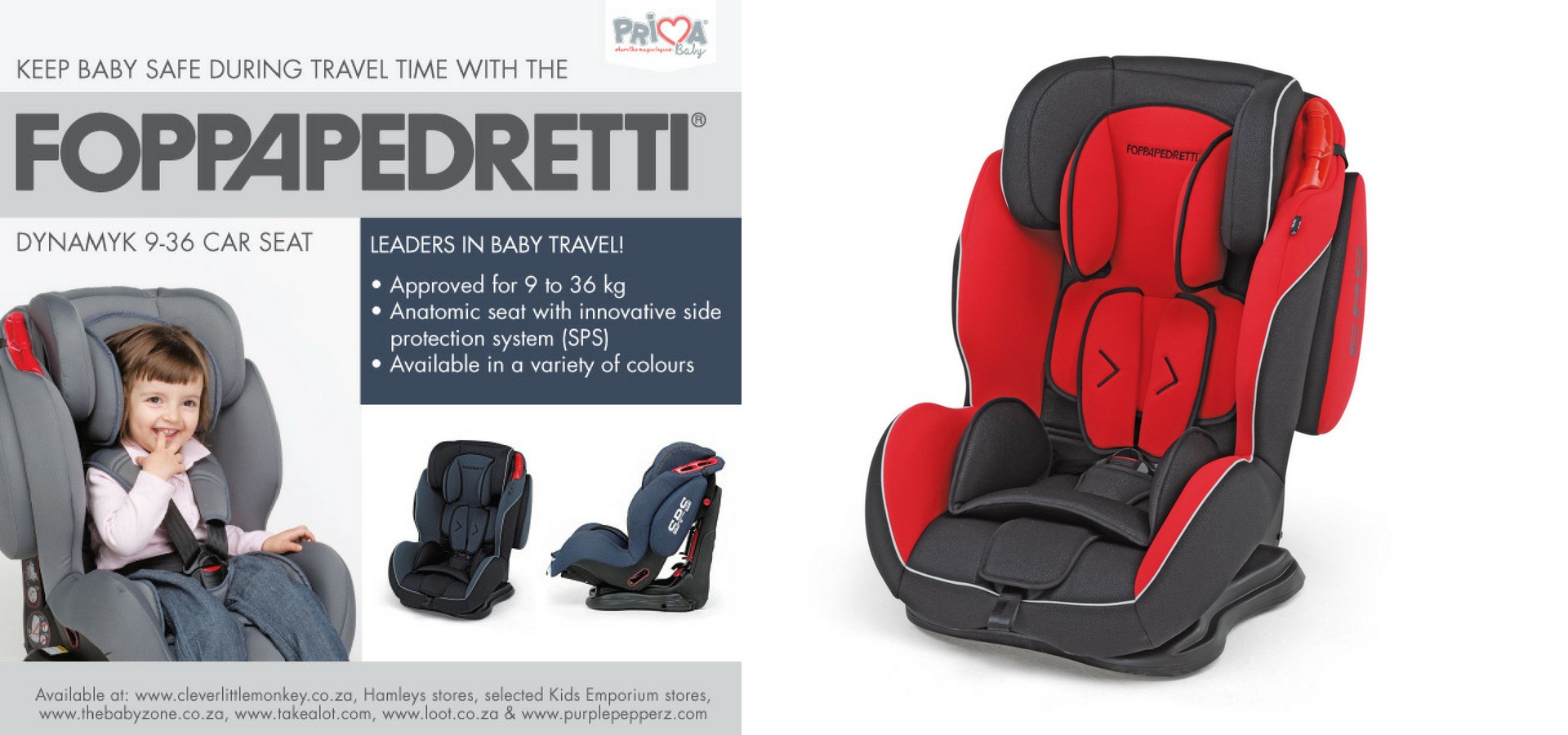#CarseatFullstop teaches us that the proper use of a correctly installed car seat greatly reduces a child’s risk of injury or death. If you feel like you are just fine, so did I… But, here’s another dose of sobering stats… Especially for us parents who thought they could breathe a sigh of relief, since we diligently bought the seats and strapped our kids in… Most of us are making life-threatening car seat mistakes every day.
Car crashes remain one of the leading cause of unintentional injury-related death among children under 14 in South Africa. No doubt, in part, because 4 out of 5 car seats are used incorrectly… And nearly a third of children ride in incorrect restraints for the size and age. Those are a whole lot of car seat mistakes!
Dude! FOUR out FIVE car seats are not being used correctly!! That’s just mental! You do the maths on that and you’ll realise that between you and me, we may unfortunately probably be a part of those scary statistics.
In fact, there’re a slew of common car seat mistakes that many well-intentioned parents unknowingly and innocently make. I was one of those parents – despite me thinking that I was so clued up (aka slightly anal) about it. And chances are, you could be too. Because, yes, you can actually balls up the installation and use very easily if you’re not aware of it… Reducing your child’s survival rate should you ever – heaven forbid – end up in a crash. But, now that I know better, I do better. So let’s not beat ourselves up. Instead let’s get to grips with these common mistakes, let’s get informed and take steps to rectify them.
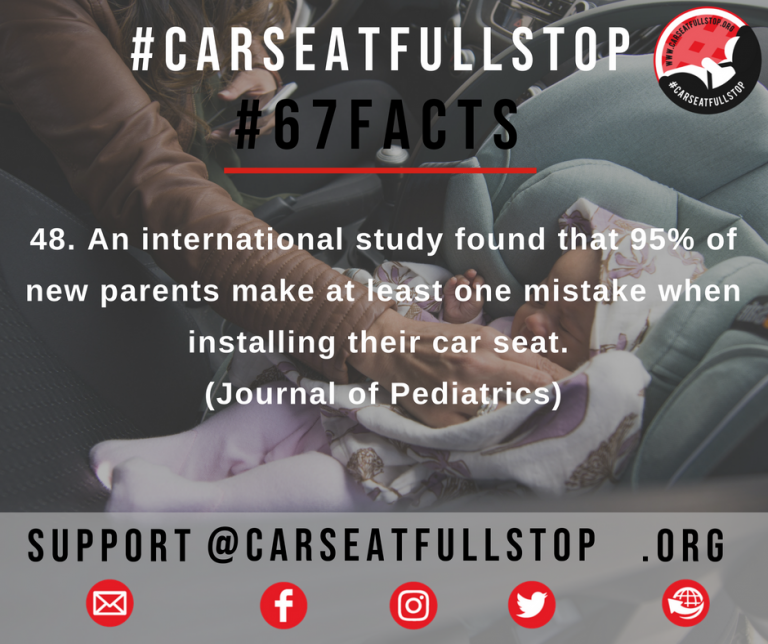
And, no, don’t worry, I’m not going to slip on my judgey-judgetan pants (lest I want to judge myself)… This campaign, and certainly this post of mine, is here to create awareness and help you keep your precious cargo safer on the road. So let’s do this!
There are quite a few car seat mistakes that us parent folk make. In fact, there are plenty that can get extremely technical. But for now, let’s start with the basics, and gain mastery over those first, shall we?
I’ve broken it down into the most common car seat mistakes that so many parents make (The Mistake)… Along with the rationale behind why it is a risk (The Risk)… And finally, the suggested solution for each of these car seat mistakes (The Fix).
So, you’ve got the car seat. Well done, you’re already winning!
Let’s look at 11 of our most common car seat mistakes
1. Car seat should not move more than 2cm/1 inch in any direction when given a firm shake at the base.
The Risk:
- If you can move your car seat more than 2cm, it means that it is not secured tightly enough. This compromises it’s ability to safely restrain your child as intended.
The Fix:
- Read the manual. Yes, reading manuals is fun – said nobody ever! But in this case, it’s best that you do. Don’t assume that you will know how to install it, as each car and car seat has its own limits and restrictions.
- Ensure the seat belt path that loops through the car seat is as per the manual.
- Keep the car seat manual in the car for ease of reference.
- Try to find an expert familiar with your seat to check it for you for good measure. Currently, only Wheel Well in Joburg offers this service. However, you can upload photos or video clips onto the #CarseatFullstop Facebook group and one of the admins should be familiar with your seat and advise.
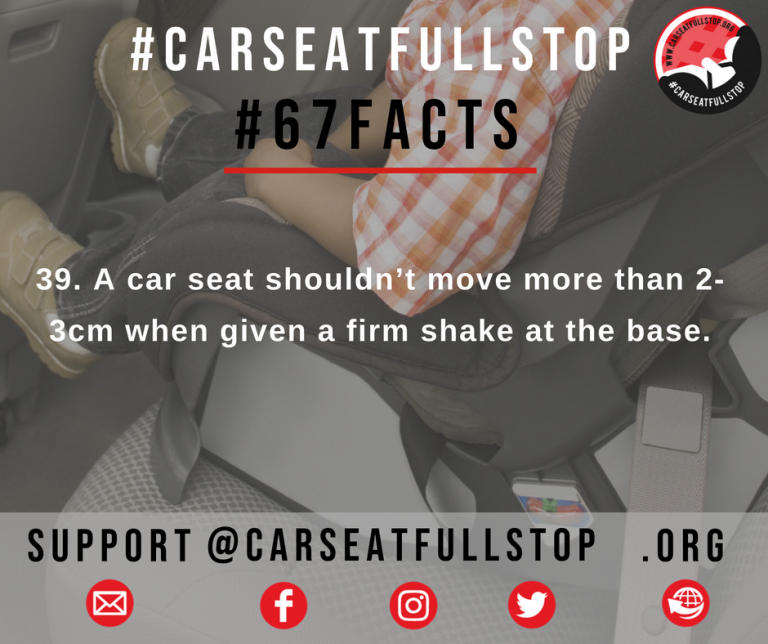
2. Car seat harness too loose
The Risk:
- The harness is intended to fit snugly against the body to bring your child to a stop as gently and safely as possible. However, any slack creates space between your child’s body and the harness. The harness becomes an object for your child’s delicate bones to slam into at great force (force enough to cause injury) and causes a terrible jolt for baby’s delicate spine.
- Any slack enables your child to easily slip their arms out of harness, compromising the car seats ability to safely secure them during an accident.
- The harness needs to be tight enough.
The Fix:
- Not sure what’s tight enough? Well, once your child is strapped in, you should not be able to fit more than one finger in between your child’s collarbone and the harness.
- Or try the pinch test. The harness needs to be taut enough that you’re unable to pinch even a little bit of slack in harness.
- Tighten until you pass the pinch test.
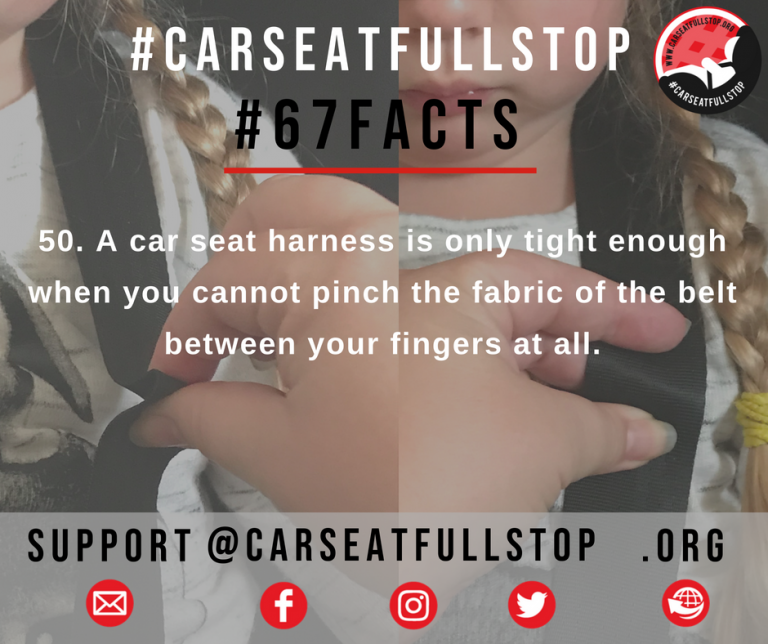
3. Using any accessories that are not certified for use in particular car seats
The Risk:
- Car seats are subjected to extensive testing. You may create an untested configuration by using an after-market product with the seat.
- Think head positioners, back supports, chest clips, car seat covers, etc. If it does not come standard with the car seat or is not certified as being tested and safe to use with your specific car seat, it may introduce unnecessary risk.
- For example, non-standard chest clips (illegal in South Africa) could cause internal damage to your baby’s soft and delicate innards during an accident, due to the resultant force that comes at time of impact. Not worth the risk, is it?
The Fix: Avoid the use of any accessories with your car seat, unless your car seat manual approves their use.
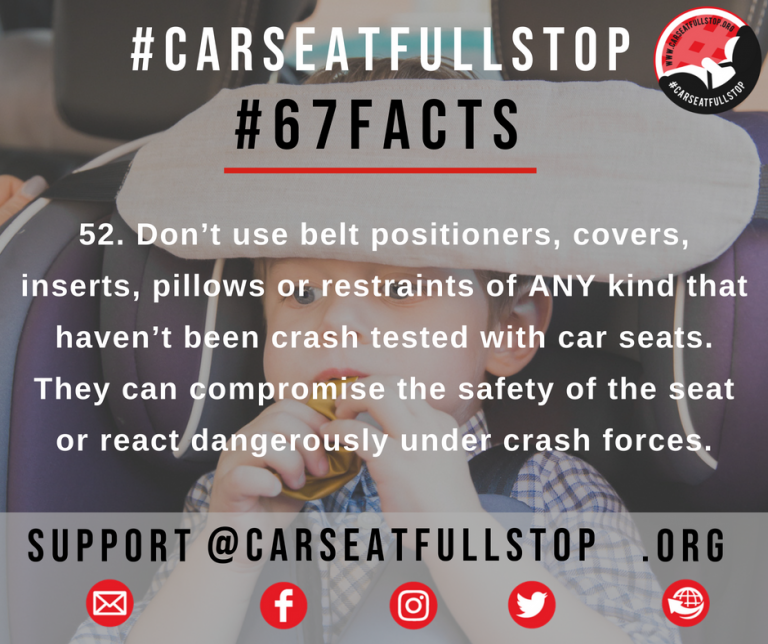
4. Incorrect height of harness and straps
The Risk:
- Correct shoulder harness height is vital to reducing your child’s movement in the event of a car crash or sudden stop. See point number 2 with regards to the slackness of the harness.
- If it’s too high, it allows too much space and slack in the harness for it to secure your child adequately during a crash.
The Fix:
- Ensure that rear-facing car seats have the straps that come out of the seat at or below the height of the shoulders.
- Forward-facing seats should have the straps coming out at or above.
- Seat belts for children in boosters should go across their pelvic bones or top of thighs, not across their tummies and the top strap should not touch their neck.
- It is important that the height of the harness be adjusted so that the straps exit the back of the seat at or below your child’s shoulder height. Read your car seat manual for specifics on how to adjust it, and what height it should be at for your child.

5. Children wearing bulky clothes (like jackets) in car their seat
The Risk:
- Yes, it can get cold out there, and we want to bundle up our babies. However, a thick puffy coat or jerseys is a big car seat no-no. On impact, all that puffiness and padding of the jacket compresses, resulting in the harness actually being loose and unsecure. (see point 2.)
The Fix:
- There are plenty of ways to keep our babies warm… And still safe and secure in their car seat. Cover your child OVER the seatbelt. Use thin layers, but double-up.
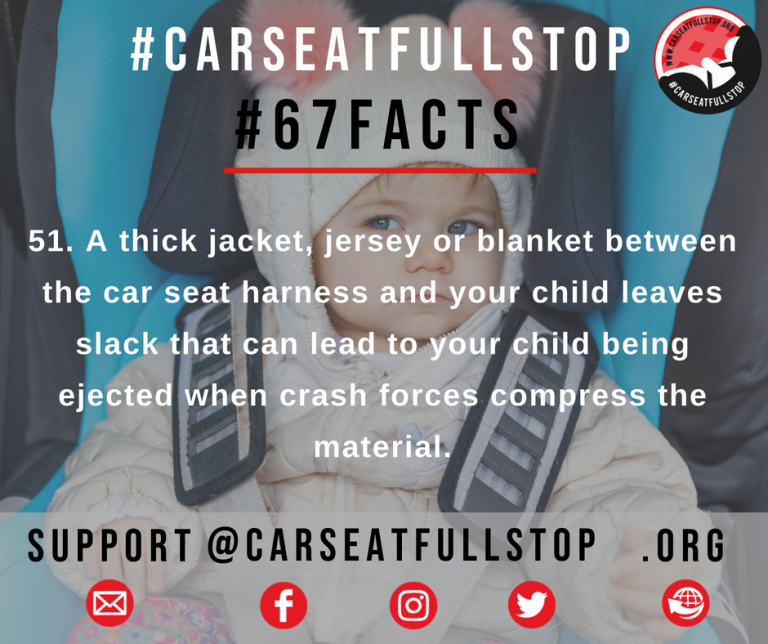
6. Twisted straps
The Risk:
- If the straps are twisted, they are unable to evenly distribute the impact of a crash. Which means they can’t give full protection to your child and they could end up getting hurt.
The Fix:
- Take the time to check for any twists everytime you strap your child in.

7. Moving from rear-facing to forward-facing seat too early
The Risk:
- Part of what makes babies and toddlers so bloody cute is their big heads in proportion to the rest of their body. However, it’s that very thing – the proportional weight of their big heads to the weak neck muscles, that put them at much greater risk during a car crash. (Have you see some of the crashtest vids on YouTube? Holy crap – it’s hectic.) Children under four are particularly vulnerable to this.
- Needless to say, should you be in a car crash, and your child’s head gets thrown in any direction, their small and still developing neck muscles simply won’t have the strength necessary to keep their head safely in line with the spine. Ever heard of “internal decapitation”? Well that’s the horror that would ensue – where the head is forcibly disconnected from the spine.
The Fix:
- In a head-on collision, rear-facing seats reduce injury risks by 90% compared to unrestrained kids. Which is over 20% safer than children wearing just a seatbelt (68% lower risk of injury).
- Considering this, keeping children under the age of four in rear facing seats is highly recommended. For more on rear-facing seats, see here.
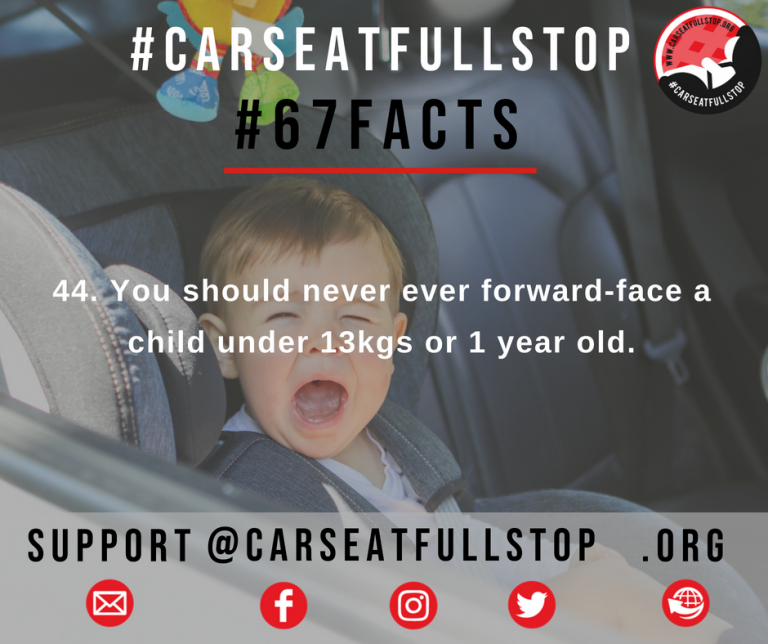
8. Moving to the seat belt too early
The Risk:
- What is key to note is that seat belts were originally designed for grown men – not children.
- Yet, so eager to move on from the booster seat and straight to the seat belt alone, many parents make the mistake of moving their child too early.
- “Too early” is when the seat belt doesnt fit correctly. And a poorly fitted seat belt can do more harm than good – just think, splicing up your innards, as it pushes through your spleen and liver… Or, if the shoulder strap fit is slightly off, then the resultant head injuries are a given, not to mention the spinal injuries that are a high probabilty. It’s just not a pretty picture, and certainly not worth the risk.
The Fix:
Well, how do you know if your child is ready for the seat belt?
When your child is over 1.5m tall AND can –
- Sit with their back firmly against the back rest of the vehicle’s seat
- With their feet firmly on the vehicle floor and their knees bent comfortably over the edge of the seat without slouching
- The seatbelt crosses the chest from between the neck and arm,
- While the lap part is low across the tops of their thighs
- And more over that your child can remain seated in that way for the entire trip.
If you ticked all the boxes (at the same time), then your child is ready. However, if your child does not meet ALL of these requirements, then he/she needs to remain in a full back booster seat.
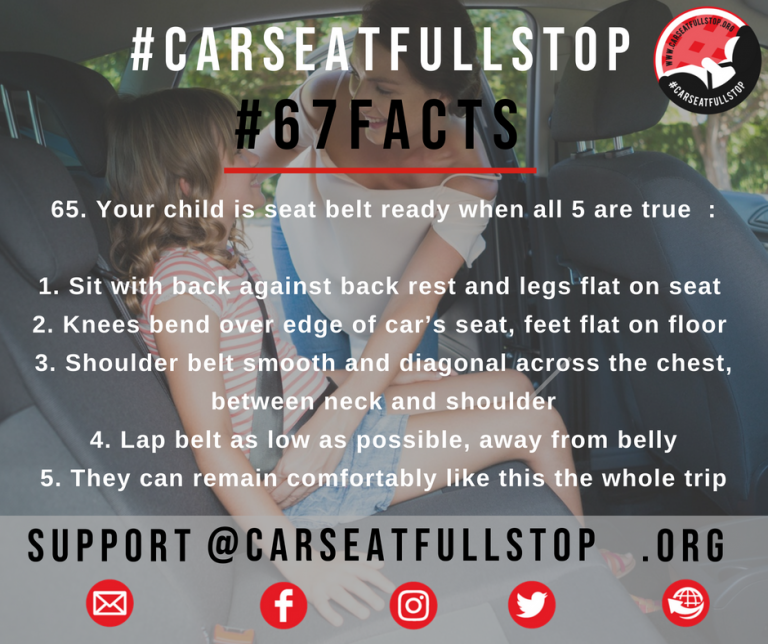
9. Assuming three car seats across will / won’t work
The Risk:
- Don’t assume your car is too small to accommodate three car seats at the back… This could result in your moving one or more children to booster seats, or worse to seat belts, before they are ready.
- Just as dangerous, don’t assume that your car is big enough to fit three car seats across, where the configuration simply won’t work. There is great risk in the car seats not all being able to safely fit across the back seat due to due lack of space and the broad base of many car seats.
- Similarly, not all car seats will fit into a spacious back seat, purely due to the configuration of the middle back seat and its seatbelt spacing.
- In all situations, the ability to safely secure a child may be greatly compromised due to the incorrect installation of car seats that are not suited for your particular car.
The Fix:
- Firstly, three seats across is very doable. In fact, totally doable. However, you will need to do thorough research on the various bases of car seats and how they would work with your car’s back seat space, as well as your car’s seat belt configuration. And remember, if in doubt, Wheel Well or the #CarseatFullstop Facebook group is a call away.

10. Incorrect spacing between car seat and vehicle front seat (Applies more to rear- facing seats)
The Risk:
- The front seat position being set in a way that may interfere with the child restraint system. You must check your car seat manual to find out whether your car seat can touch the car’s front seats or what the minimum space should be.
- If the space is too small between the carrier and the front seat, it may be difficult to ascertain whether the car seat is truly firmly clicked and locked into the base as intended. Or that it is securely installed with the belting system used.
- If the space is not big enough, the front seat may become a risk for a secondary impact in a crash.
The Fix:
- Check your manual for specifics.
- When installing any child seat, push the front seat as far foward as possible. Thereafter, move the seat into the position advised in the car seat manual.
- The general rule is that either the seat should be touching (though not supported by) the front seat or a minimum of 25cm space to prevent secondary impact.
11. Buying second hand car seats blindly
The Risk:
- Unless you’re getting your second car seats from Wheel Well, where you know experts have done their best to check the seats thoroughly to ensure the seats are safe, there are key facets you need to check to ensure the integrity of that second hand seat, before you even think of buying. Otherwise you risk the car seat having been recalled or in an accident without your knowledge, thereby compromising its integrity and safety.
The Fix:
- Wheel Well receives donated car seats to create a “seat exchange”. The seats are thoroughly cleaned and checked for defects before being put into stock, where lower income families can buy a car seat in return for an affordable donation.
- Read our stories on second hand car seats. You can also speak to Wheel Well who will gladly advise you in this regard.
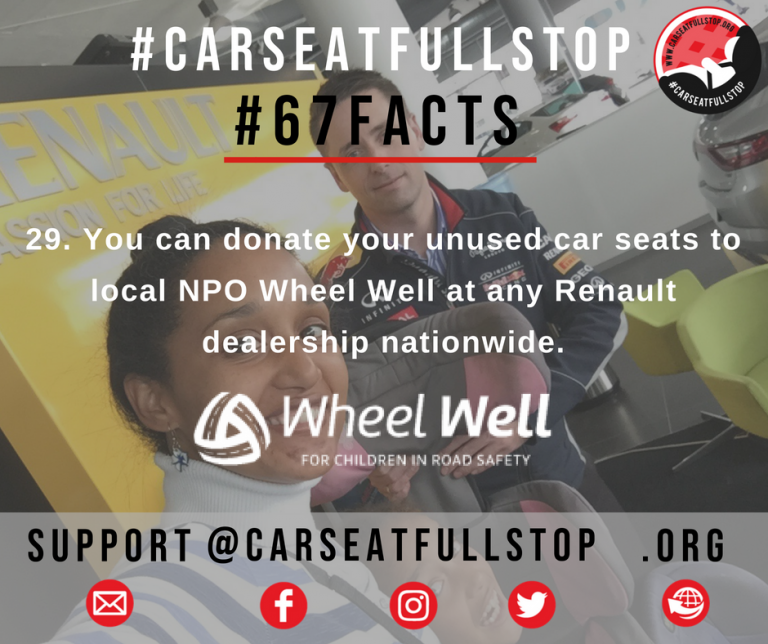
We, as parents, are all just trying to do our best – at least that’s what I’d like to think. But we’re also human! We’re rushing around most of the time, we’re susceptible to our emotions, and are just down right tired. (Am I right?) So we’re all prone to human error and making honest mistakes along the way.
But there are certain things where we need to be sure we’re pouring our energies into no matter what… Making the responsible choice to always make our children’s safety our number one priority, is certainly one of them. Car seat safety is the one aspect of parenting that you really want to nail. Avoiding any one of these car seat mistakes could literally save your child’s life.
As a parent, where I believe that all little lives matter, I would sincerely encourage you to address this matter as the serious concern that it is, commit to doing the right thing, and to take the time to get the use and installation right. We all make car seat mistakes, but let’s change that because our precious cargo make it more than worth it.
Here’s to knowing and doing better, and saving little lives! X
About the Author

Tracey is a very proud mommy to Morgan-Lee (7), Parker-Grace (4), Coco (1) and they are expecting baby number 4!! She writes over at The Milk Memoirs, when she isn’t working full time in the ICT industry.
Tracey on #CarseatFullstop
When you become a parent, suddenly all children’s safety become a concern purely by extension of your parental heartstrings. I am part of this campaign to help be a voice that will trigger true introspection about our society’s current disconnect between the severe lack of carseat safety and the risks that are involved.
A voice that appeals to the intellect and the heart of every parent out there to create this shift in mind set. A mind set that is not only about legal compliance and safety regulations, but about becoming proactively safety-aware. A mind set that actively seeks out safer options for their children no matter what.
Furthermore, in spreading this consciousness, hopefully we can create a better ecosystem of car seat safety within our society.
These are all things that are currently lacking in our society. If we want people to make the change, we need to provide adequate support services to make it sustainable change. This campaign has the potential to accomplish all of that, if we work together.
Read & Share – Our precious cargo
You have the power to save a little life. One share, seen by one person, who straps in one child, saves a life. #CarseatFullstopOne share, seen by one person, who straps in one child, saves a life.
- When is your child booster seat ready? - November 22, 2023
- The short cuts that risk lives - August 7, 2020
- Babywearing is NOT an alternative to a car seat - July 10, 2020




